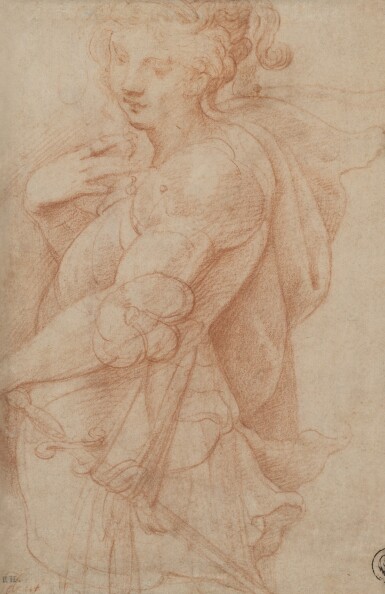
Girolamo Francesco Maria Mazzola, called Parmigianino
Study of a female figure in armor, possibly Minerva
Auction Closed
January 26, 04:31 PM GMT
Estimate
25,000 - 35,000 USD
Lot Details
Description
Girolamo Francesco Maria Mazzola, called Parmigianino
Parma 1503 - 1540 Casalmaggiore
Study of a female figure in armor, possibly Minerva
Red chalk;
bears attribution and inscription in pencil on the mount: F. Parmegiano and Coll. Wellesley
209 by 138 mm; 8¼ by 5⅜ in.
Richard Cosway (1740-1821), London (L.628);
Sir James Knowles (1831-1908), London (L.1546),
thence by descent,
sale, London, Sotheby's, 5 July 2000, lot 22;
Private Collection;
sale, New York, Sotheby's, 25 January 2002, lot 15;
Private Collection
With a very strong debt to Correggio, the present study of a female figure in armor with a sword must date from Parmigianino's early period in Parma, prior to his departure for Rome in 1524. The facial type is closely comparable to a pen and brown ink drawing of a Standing woman holding a bass violin, in Budapest,1 which is a study for the woman with the viola da gamba in the representation of St. Cecilia on one of the organ shutters of S. Maria della Steccata, Parma, a project dating from before Parmigianino's journey to Rome. Another associated study for the St. Cecilia is in the Louvre.2
Though it seems difficult to reconcile the handling in this sheet with Parmigianino's later and more mature style, Mario Di Giampaolo (see Literature) has proposed instead a dating during the artist's stay in Rome (1524-1527). He also observed that Parmigianino executed studies for a Minerva on other, even later occasions, citing a pen and ink study of Minerva unsheathing her sword,3 which relates to the small statuette in the bottom left corner of the portrait of Pier Maria de' Rossi, Count of San Secondo (circa 1535-1538), now in the Prado.4
1. Budapest, Museum of Fine Arts, inv. no. 2108 (recto); A.E. Popham, Catalogue of the Drawings of Parmigianino, London 1971, vol. I, no. 37 (recto), reproduced vol. II, pl. 25
2. Paris, Musée du Louvre, inv. no. 6456; Popham, op. cit., vol. I, no. 435, reproduced vol. II, pl. 24
3. Formerly Steiner Collection, and sale, London, Christie's, 9 December 1975, lot 15; D. Ekserdjian, 'Unpublished drawings by Parmigianino. Towards a Supplement to Popham's catalogue raisonné,' Apollo, 1999, p. 37, no. 65, reproduced, p. 35, fig. 83
4. Madrid, Museo Nacional del Prado, inv. no. P00279
You May Also Like










